
The Role of Glucuronidation in THC Metabolism and Elimination
Introduction
Tetrahydrocannabinol (THC) is the main psychoactive substance found in cannabis, known for both its therapeutic and mind-altering effects. Understanding the body’s process of metabolizing and eliminating THC is crucial for both medical and recreational users. This article will discuss the process of THC glucuronidation, a metabolic pathway that transforms THC into a more easily excreted form.
Glossary of Terms
- Glucuronidation: A metabolic process where a sugar molecule called glucuronic acid is added to a compound.
- Glucuronosyltransferases: Enzymes that facilitate glucuronidation.
- Enterohepatic Circulation: The recycling process of a compound between the liver and intestines.
- Pharmacokinetics: The study of how drugs are absorbed, distributed, metabolized, and excreted by the body.
THC Glucuronidation in the Liver
Once consumed, THC enters the bloodstream and is transported to the liver. Inside the liver, enzymes known as glucuronosyltransferases initiate the process of glucuronidation. This involves attaching a molecule of glucuronic acid to THC, resulting in a new compound called THC glucuronide. Unlike THC, this new compound is water-soluble, making it easier for the body to eliminate.
Secretion of THC Glucuronide
After its formation in the liver, THC glucuronide is expelled from liver cells into the bile. Specialized transport proteins, like multidrug resistance-associated proteins (MRPs), are responsible for this movement. From the bile, THC glucuronide is eventually sent to the intestines.
Enterohepatic Circulation and THC Reabsorption
Upon reaching the intestines, THC glucuronide may go through enterohepatic circulation. In this process, the compound is reabsorbed from the intestinal lining back into the bloodstream. This recycling mechanism can prolong the presence and effects of THC in the system.
Elimination of THC Glucuronide
Once reabsorbed, THC glucuronide travels back to the liver or moves to the kidneys. At the kidneys, it’s filtered and becomes part of the urine, ultimately being excreted during urination. THC glucuronide is less psychoactive compared to its parent compound, THC, helping to reduce its effects over time.
Clinical Significance and Therapeutic Potential
The glucuronidation process is pivotal in medical cannabis use. It has implications for treating various conditions like chronic pain, nausea, and muscle spasms. Understanding the nuances of THC metabolism—such as how individual genetics or drug interactions can affect it—enables healthcare professionals to optimize dosing and effectiveness of cannabis-based treatments.
Conclusion
The process of THC glucuronidation and secretion is vital for understanding how THC is metabolized and eliminated from the body. The steps include the conversion of THC to THC glucuronide, its secretion into the bile, potential reabsorption, and eventual elimination through urine. This metabolic pathway holds significance for the ongoing development of cannabis-based medical treatments aimed at improving patient well-being.
📗 Note: If the diagram piqued your interest, the book will absolutely blow your mind. Mind-blowing available here 📗

Summary Notes
Exploring the Role of Glucuronidation in THC Metabolism and Elimination
Glucuronidation plays a pivotal role in the metabolism and elimination of tetrahydrocannabinol (THC), the psychoactive component of cannabis. This biochemical process, primarily occurring in the liver, involves the addition of glucuronic acid to THC, making it more water-soluble and thus easier to eliminate from the body. Understanding this mechanism is crucial for comprehending how THC is processed and how long it remains detectable in the system.
The efficiency of THC glucuronidation can vary significantly among individuals, influenced by genetic factors, liver enzyme levels, and overall liver health. These differences account for the variability in drug testing outcomes and the duration of THC’s effects. Furthermore, certain genetic variations can lead to slower metabolism rates, impacting the individual’s response to cannabis and susceptibility to prolonged effects or potential drug interactions.
Dietary habits and specific inhibitors or inducers of glucuronidation enzymes can also affect the rate at which THC is metabolized. Knowledge of these factors is essential for individuals undergoing drug testing or those interested in managing the duration of cannabis’s effects. Additionally, understanding the glucuronidation process provides insights into the pharmacokinetics of THC, including its half-life, which has direct implications for clinical applications, drug efficacy, and potential side effects.
Recent research has begun to shed light on the complex interplay between THC and the glucuronidation process, highlighting the importance of this pathway in determining the pharmacological and toxicological profiles of THC. As the legal landscape surrounding cannabis use continues to evolve, so does the interest in optimizing THC’s therapeutic benefits while minimizing risks associated with its consumption.
The clinical implications of THC glucuronidation extend beyond drug testing to include considerations for drug interactions, personalized medicine, and treatment plans for medical cannabis users. By enhancing our understanding of THC metabolism through glucuronidation, researchers and healthcare providers can better predict and manage the outcomes of cannabis use.
Future directions in research are poised to further elucidate the role of glucuronidation in THC metabolism, promising to unlock new strategies for detoxification, tolerance management, and the personalized administration of cannabis-based therapies. As our knowledge expands, educating cannabis users about the significance of glucuronidation in THC metabolism becomes increasingly important, empowering individuals to make informed decisions about their consumption habits.

